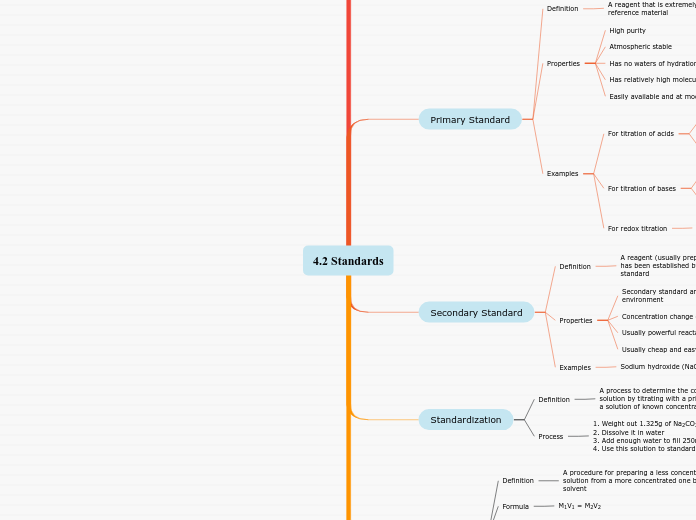4.2 Standards
Definition
Standard Solution
A reagent solution of accurately known concentration
Stock Solution
A concentrated solution that will be diluted to some lower concentrated for actual use
Working Solution
A name given to a chemical solution made for actual use in the lab, usually made from diluting or combining stock or standard solution
Primary Standard
Definition
A reagent that is extremely pure and serve as a reference material
Properties
High purity
Atmospheric stable
Has no waters of hydration (non hydroscobic)
Has relatively high molecular weight
Easily available and at modest cost
Examples
For titration of acids
i) Sodium carbonate, Na2CO3,
mol wt= 105.99 g/mol
ii) tris-(hydroxymethyl)aminimethane,
(CH2OH)3CNH2 mol wt= 121.12 g/mol
For titration of bases
i) potassium hydrogen phthalate (KHP): KHC8H4O4, mol wt= 204.23 g/mol
ii) potassium hydrogen iodate : KH(IO3)2,
mol wt= 289.92 g/mol
For redox titration
potassium dichromate : K2Cr2O7,
mol wt= 294.19 g/mol
Secondary Standard
Definition
A reagent (usually prepared in the laboratory) whose purity has been established by standardizing it against a primary standard
Properties
Secondary standard are influenced atmosphere / environment
Concentration change over time
Usually powerful reactants
Usually cheap and easy to use
Examples
Sodium hydroxide (NaOH)
Standardization
Definition
A process to determine the concentration of a solution by titrating with a primary standard or with a solution of known concentration
Process
1. Weight out 1.325g of Na2CO3
2. Dissolve it in water
3. Add enough water to fill 250mL volumetric flask
4. Use this solution to standardized the HCl acid
Dilution
Definition
A procedure for preparing a less concentrated solution from a more concentrated one by adding a solvent
Formula
M1V1 = M2V2
How to do?
How many cm3 of a 10.00M HCl stock solution would you use to prepare 5dm3 of 0.5M HCl
M1 = 10.00 M M2 = 0.5 M
V1 = ? V2 = 5 dm3
M1V1 = M2V2
(10)V1 = (0.5)(5)
V1 = 0.25 dm3
